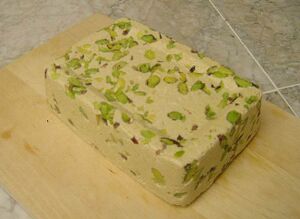Halva

Halva (halwa, halvah, halava, helva, halawa, ħelwa), originally derived from the Arabic root ḥalwā (sweet), is used to describe many distinct types of sweet confection, across the Middle East, Central Asia, South Asia, and the Balkans. Halva based on semolina is popular in India, Iran, Turkey, Somalia, Pakistan, and Afghanistan. Another common type, based on tahini (sesame paste), is popular in the eastern Mediterranean and Balkan regions, in countries such as Bosnia and Herzegovina, Croatia, Romania, Serbia, Montenegro, Bulgaria, Russia, Greece, Cyprus, Malta, Egypt, Iraq, Palestine, Israel, Lebanon, the Republic of Macedonia, Albania, Northern Cyprus, Syria, Central Asia, Caucasus region and Turkey. Halva may also be made from a variety of other ingredients, including sunflower seeds, various nuts, beans, lentils, and vegetables—such as carrots, pumpkins, yams, and squashes.
Find recipes that contain 'Halva'
#halva #sesame #carrots #nutsgrainsandseeds #lentils #beans #sunflowerseeds #pumpkins #preparedfoods #yams #nuts